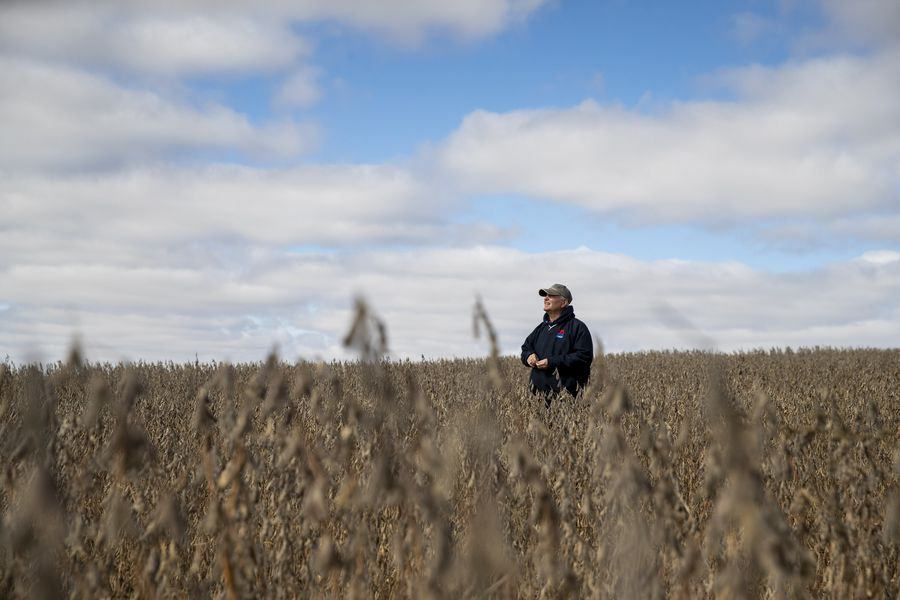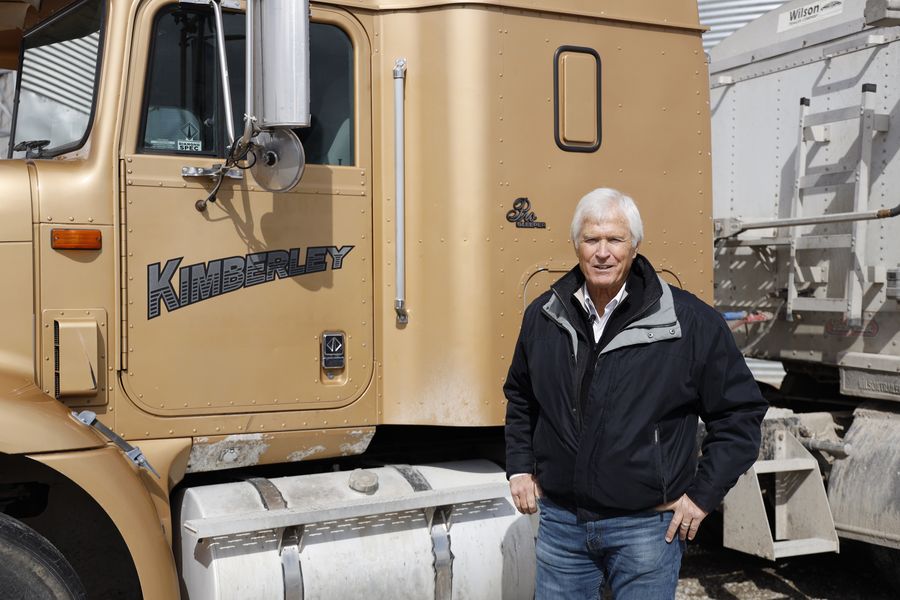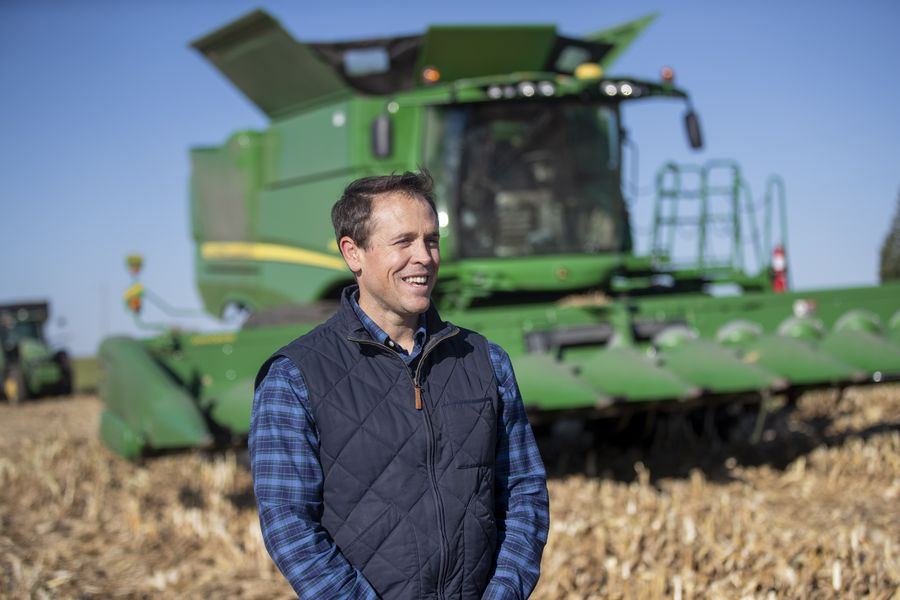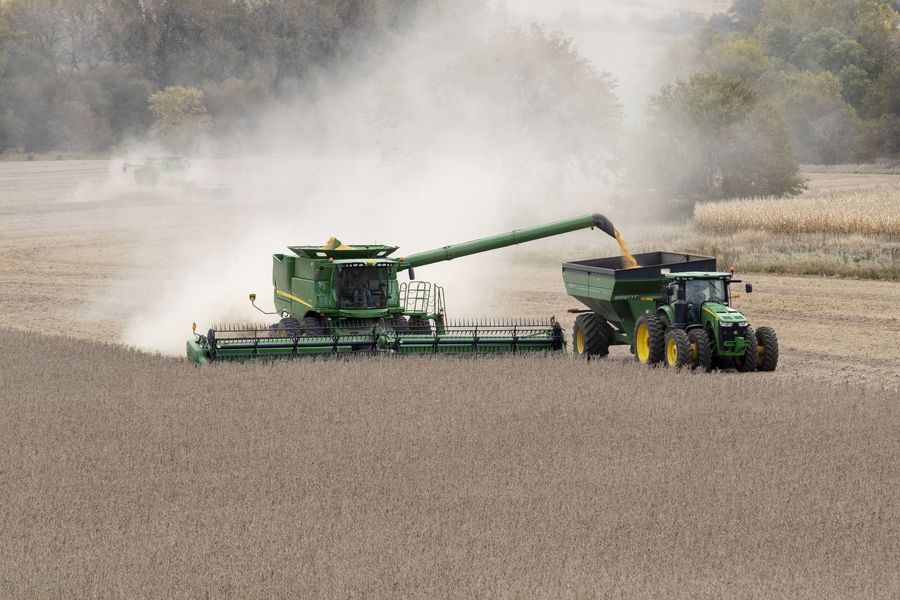
Farm owner Bill Pellett is seen among soybean crops in a field of his family farm in Atlantic, a small city in the Midwestern state of Iowa, the United States, Oct. 16, 2019. (Xinhua/Wang Ying)
"It's time to turn the page," after U.S. agriculture has been caught in the trade dispute crosshairs.
by Xinhua writer Yang Shilong
NEW YORK, Dec. 22 (Xinhua) -- U.S. soybean farmers got a reprieve at the end of a tough 2019 after the United States and China agreed on the text of a phase-one economic and trade agreement in mid-December.
"I think it's good news that both sides are talking and both sides have agreed to the deal," Grant Kimberley, director of market development at the Iowa Soybean Association, told Xinhua in a recent phone interview.
"I think everybody is optimistic and happy to hear that progress has been made," he said. "Let's hope that the positive news continues. It'll be good for both countries."
Grant's father, Rick Kimberley, who is president of Kimberley Farms Inc., also shared his comments via Chinese social media platform WeChat: "I am pretty excited to hear the good news. It's a win-win and it's beneficial to us as well as Chinese consumers. I hope we could keep going forward and work out other issues that might be difficult to solve."
The Kimberleys have been known by many in the United States and China since Chinese President Xi Jinping (then vice president) visited their family farm in Maxwell, Iowa, in 2012.

Rick Kimberley, president of Kimberley Farm Inc., poses for a photo at his family farm in Maxwell, Iowa, the United States, on March 17, 2019. (Xinhua/Li Muzi)
YEAR OF UNCERTAINTY
The year 2019 has been "challenging" for U.S. soybean farmers as they were hit hard by tariff impacts as well as historic wet weather in the Midwest, Grant said.
"Uncertainty has been the name of the game this year because of all the twists and turns, and (it is) almost like watching a movie of having the various plot points change in direction," he said.

Grant Kimberley, director of market development at the Iowa Soybean Association, receives an interview at his family farm in Maxwell, the U.S. state of Iowa, Oct. 17, 2019. (Xinhua/Wang Ying)
The U.S. administration has since 2018 imposed several rounds of additional tariffs on Chinese imports, initiating a prolonged trade dispute between the world's two largest economies.
As countermeasures, China levied tariffs on a list of items imported from the United States, including some agricultural products such as dairy.
In the 2017 fiscal year, U.S. farmers and ranchers exported about 22 billion U.S. dollars' worth of agricultural products to China.
The agricultural exports to China will fall to just 6.5 billion dollars in the 2019 fiscal year, according to projections by the U.S. Department of Agriculture.
Prior to the tariff battle, "about one third of all the soybeans grown in the United States were destined for China," said Grant.
Now Iowa soybean farmers have to offset some of that loss by increasing their exports to other countries, "but China certainly is one of the largest consumers of soybeans in the world, and so it's hard to offset all of that," he said.
Soybean farmers have to start making plans for the next crop season soon and "more market certainty" is what they would like to see, he said.
"We want to remain as trade partners," said Bill Pellett, adding it would be "very difficult" to decouple the U.S. and Chinese economies.

A combine and a grain cart work in a soybean field of Pellett family's farm in Atlantic, a small city in Iowa, the United States, Oct. 16, 2019. (Xinhua/Wang Ying)
The fifth-generation farmer from Atlantic city in Iowa managed to sell most of his soybeans last year, but for a lower price.
Like the Kimberleys, Pellett sold some of his newly harvested soybeans this year and put the rest in storage, waiting to see if prices will go up.
The financial aid programs set up by the U.S. government to help farmers weather the trade tensions might be "necessary yet not so significant," Pellett said, noting that farmers prefer trade to aid.
ASPIRATION TO RESTORE GLOBAL COMPETITIVENESS
Iowa Secretary of Agriculture Mike Naig said the phase-one trade agreement with China is good for the United States and Iowa, and it is the beginning of the changes he and Iowa farmers hope to see.
"It's something we've been hoping for and working for many months ... I think it's great evidence of continued progress," Naig said.

Mike Naig, Iowa's secretary of Agriculture, speaks during an interview with Xinhua in Des Moines, Iowa, the United States, April 26, 2019. (Xinhua/Wang Ying)
"America's farmers and ranchers are eager to get back to business globally. Progress restoring our ability to be competitive in China is a key component of that," American Farm Bureau Federation President Zippy Duvall said in a statement on Dec. 13 when the two countries announced that they have agreed on the text of the phase-one trade deal.
Calling it "welcome news," Duvall said the U.S. agriculture has been caught in the trade dispute crosshairs and "it's time to turn the page."
China has been downgraded from the second-largest market for U.S. agricultural products to the fifth since the trade dispute began, said Duvall, adding "reopening the door to trade with China and others is key to helping farmers and ranchers get back on their feet."
Pellett said that "(with) trade with China hopefully coming back quickly, the prices should improve."
"And that makes a farmer smile anytime that he can," Pellett added. ■



